The Joys of Cooking Whole Fish
It's the way to go for maximum flavor and striking presentation, with some highlights from dining out and an informal recipe for branzino
There are many things to love about cooking whole fish—prime among them being flavor.
I was reminded of that on a trip to France last fall. We were mostly in the south, from Toulouse over to Montpellier, with a number of stops along the way. I knew that we’d have some great seafood, which we did, without a doubt. The bonus was just how often that seafood ended up coming in the form of a whole fish, cooked simply, all the better to appreciate its delicate flavor.
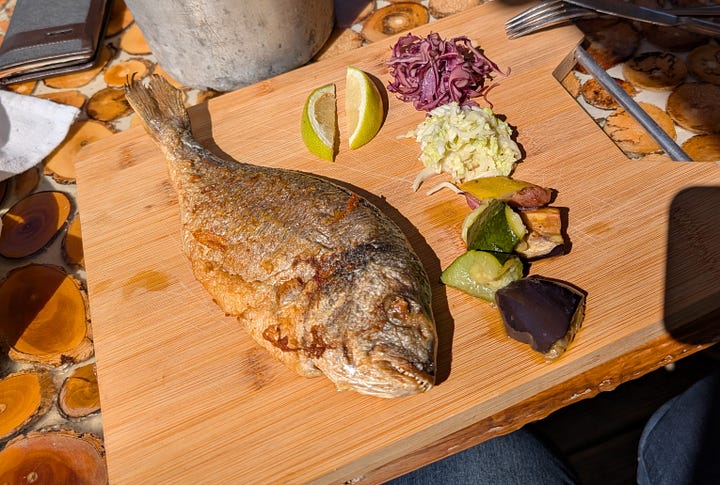

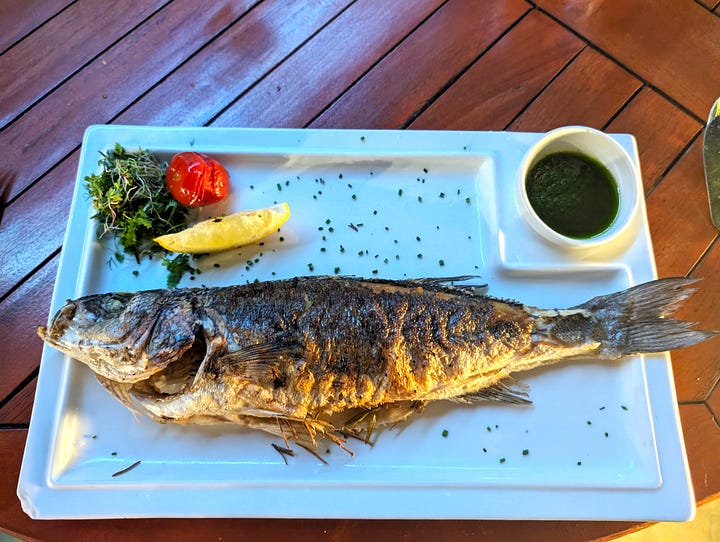
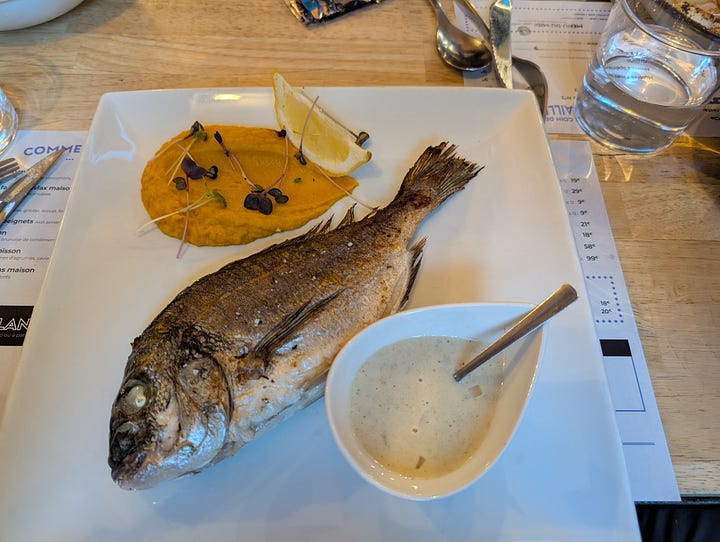
And even on trips when there’s no chance to cook any of the outstanding seafoods available, I’ll always stroll the markets to have a look at what’s available and daydream about doing so. While also taking it as hints for what to keep an eye out for on menus while in the area.
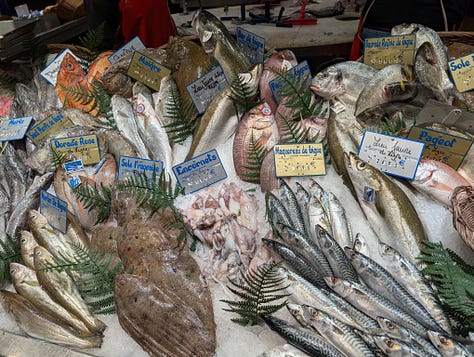
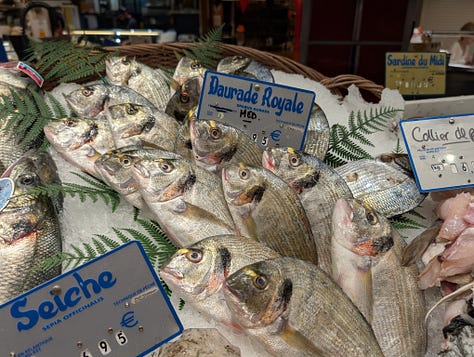
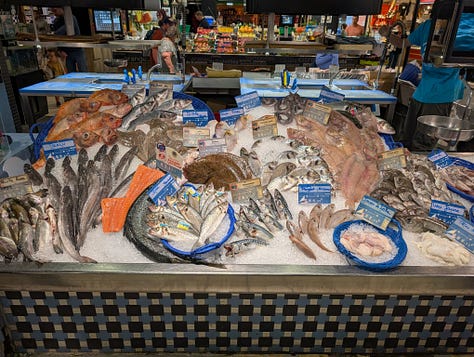
Depending on where you live, the options for whole fish may be as lush as those in Toulouse (above), or far more meager, as can be the case in retail stores with limited selection. Hopefully most folks can at least find a nice whole trout, a really great fish that I really want to encourage more folks to cook at home. I devoted a whole issue to trout recently, including a recipe for whole trout baked with ginger and lime, and one for fillets. (One other whole fish recipe I’ve shared is my Dad’s grilled salmon.)
My neighborhood grocery has trout regularly, and seasonally will carry whole salmon, maybe one or two other whole fish now and then. But they don’t have enough room in their cases to regularly have a few options to choose from. Specialty seafood markets, of course, will have more selections. I paid a visit to one of the gems among grocery stores in Seattle, Uwajimaya, which has an extensive seafood department. On this visit, I saw maybe 8 or 10 options for whole fish and picked up a couple of branzino to toss on the grill (details for that below). And I will get back before long so I can cook for more from among those selections.
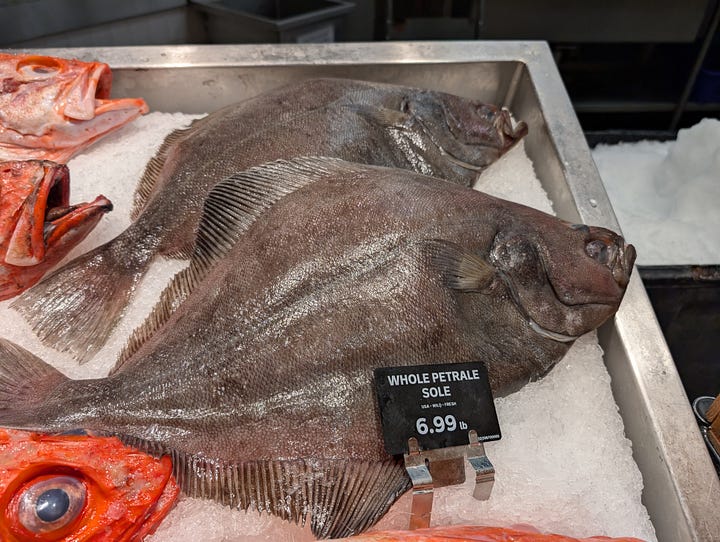

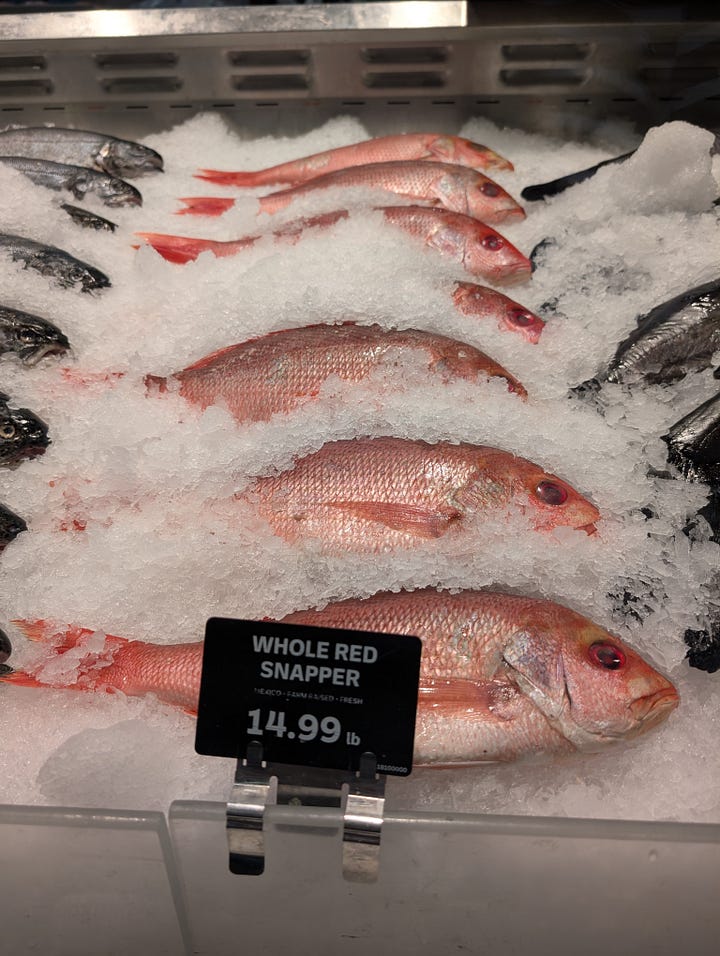
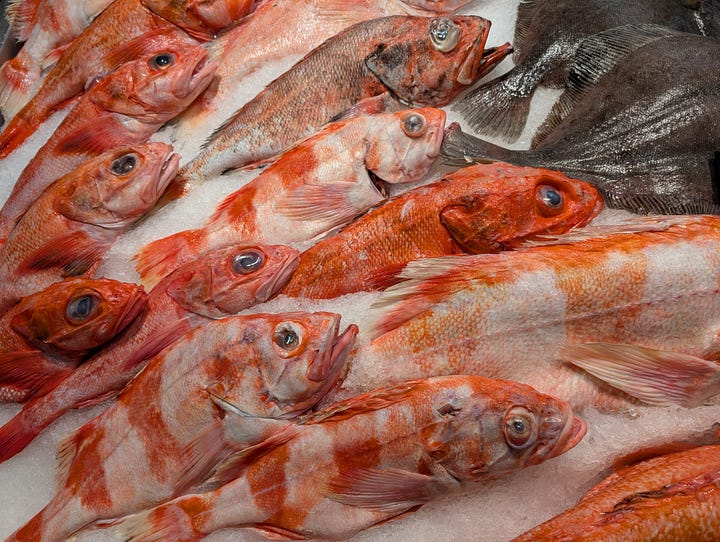
A quick little safety note: some fish can have particularly sharp spines on their fins, rockfish a good example. It’s prudent to cut them off (if they haven’t been already) to avoid any unpleasant encounters with them.
Cooking fish with skin, head, and bones intact helps insure that a maximum of flavor and moisture are retained as it cooks. And there’s not much to do before cooking, as long as you’ve got fish that are already scaled and gutted (be sure to check when you buy them; ask the fishmonger to do so if not already done).
I pretty much always turn to the oven or the grill when cooking fish whole, since there’s space to accommodate varying sizes and shapes of whole fish. And it’s easier to cook multiple small/medium whole fish at once on the grill or on a sheet pan in the oven, than trying to manage multiple fish in skillets or steamers.
You can certainly get elaborate with cooking whole fish if you want, wrapped in leaves or pastry or covered with a salt crust…maybe I’ll get into some of those options down the line. For now, just keeping it simple.
I know that cooking whole fish is one thing, and eating whole fish is another: it can be a little intimidating. It just takes a bit of practice, all the more reason to start cooking whole fish a bit more often! Before long, it’ll be a piece of cake.
For single-serving fish, like smaller trout and branzino, the simplest way to enjoy them is to just dig in and eat the top fillet, then lift off and discard the central backbone. This leaves the bottom fillet ready to enjoy. Lifting up that backbone: I usually start by lifting up the tail (you may need to make a slit in the bottom fillet near the tail end for it to easily separate), then pull up the backbone and the head typically lifts up easily (though again, you may need to cut through that end of the bottom fillet to help separate the head).
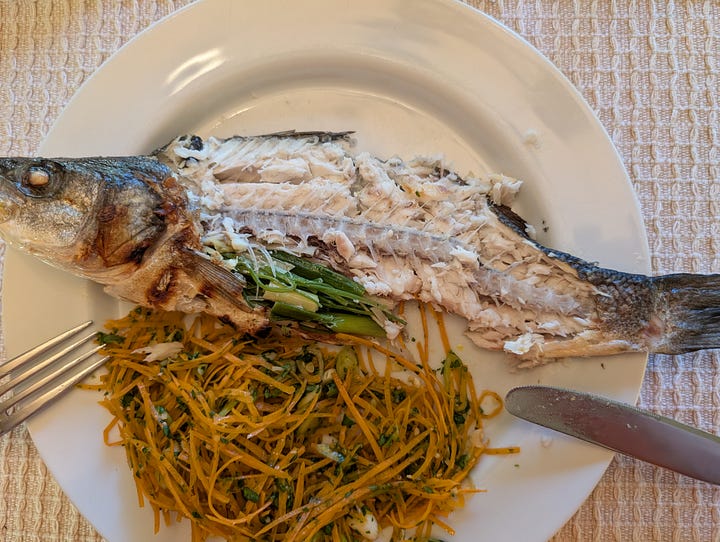
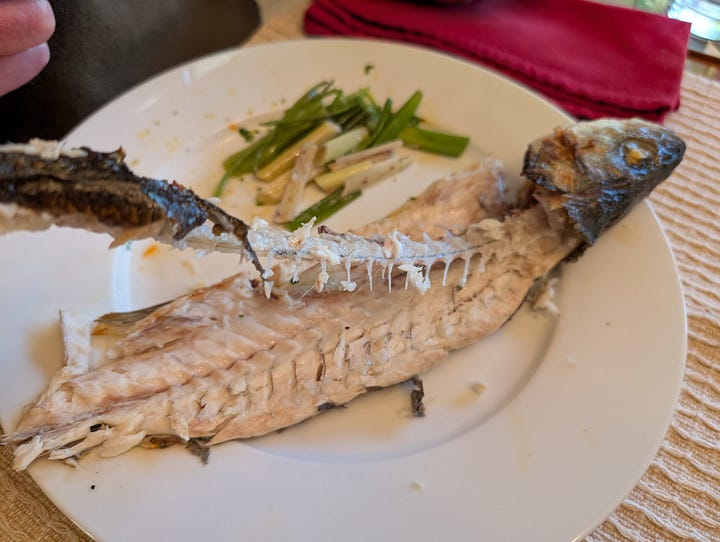
For larger fish, it takes some filleting action to serve portions from it, which I’ll focus on in a later post. I’ll be cooking my dad’s whole salmon again soon and will share steps from serving that.
Grilled Branzino with Lemongrass and Carrot-Cilantro Slaw
This is an informal recipe—sharing how I cooked this particular fish a few nights ago, more for an off-the-cuff dinner than for a formal recipe test. Its off-the-cuff style hopefully gives you an idea or two for cooking whole fish soon, whether following this combo of ingredients and seasonings, or riffing to go a different direction. That’s where the great, and delicious, fun of home cooking comes in!
I chose branzino from among the many options at Uwajimaya (above). Like trout, these were ideal single-serving size. I gather that branzino is becoming more broadly available, though trout will be an outstanding option too, with similar cooking time.
For starters I gathered:
2 branzino, each weighed about 14 ounces (they’d been gutted and scaled at the store; always be sure of that when buying whole fish), that I rinsed and dried well with paper towels, inside and out
1 stalk lemongrass, a handful of cilantro sprigs and a few green onions for stuffing and the slaw
a couple medium carrots, white wine vinegar (rice wine vinegar would be great too, I was out) and olive oil for the slaw
I trimmed the tough root and stem ends from the lemongrass and discarded a couple tough outer layers. Then I smashed the broader end and finely chopped enough to measure 2 teaspoons. The rest of the stalk I cut into 2-inch pieces.
I plucked leaves from the cilantro sprigs, saving the stems, and chopped the leaves (I had about 3 tablespoons’ worth). Then I trimmed the green onions and thinly sliced the white and light green portions and cut the green tops into 2-inch pieces.
For the carrot slaw, I finely julienned the carrots (coarsely grating would be good too), and tossed them with the minced lemongrass, chopped cilantro, and sliced green onions. Then a drizzle of vinegar (a couple tablespoons) and oil (a few tablespoons) plus some salt and pepper, toss to mix and set aside while cooking the fish.
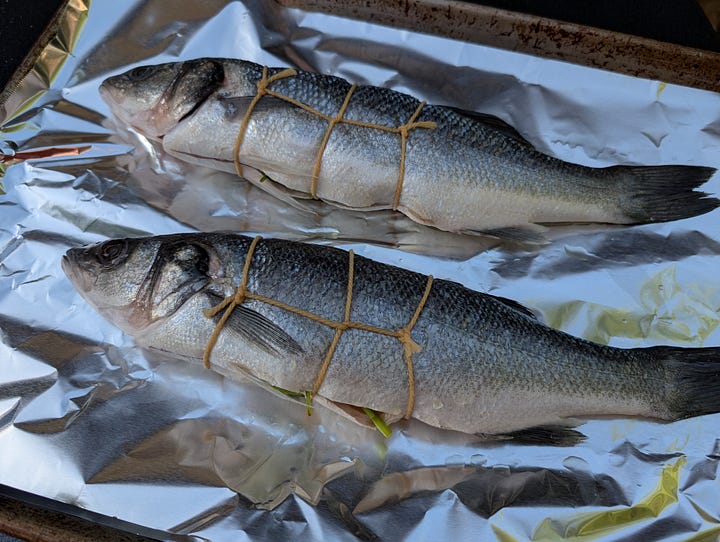
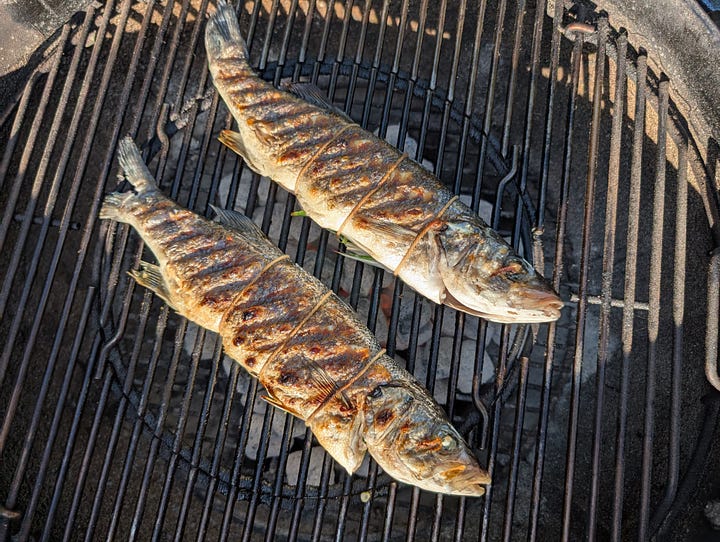
I filled the branzino cavities with the pieces of lemongrass and green onion tops and the cilantro sprigs, then used some kitchen twine to ensure it all stays put during cooking. I rubbed a couple tablespoons of oil over the fish, set them on a medium grill (I’m a coal griller, the temp reading was in the 375-400°F range). The fish cooked for about 15 minutes total, until nicely browned on each side and the flesh no longer translucent when I cut into a thicker part of the fillet.
Discard the twine and serve those beautiful fish with the carrot slaw alongside.






When I took a cooking class in France a long time ago I had mackerel for the first time. I liked it a lot. I have never fixed it and I have not seen it on any restaurant menus. I may have to try making it myself. Great newsletter.